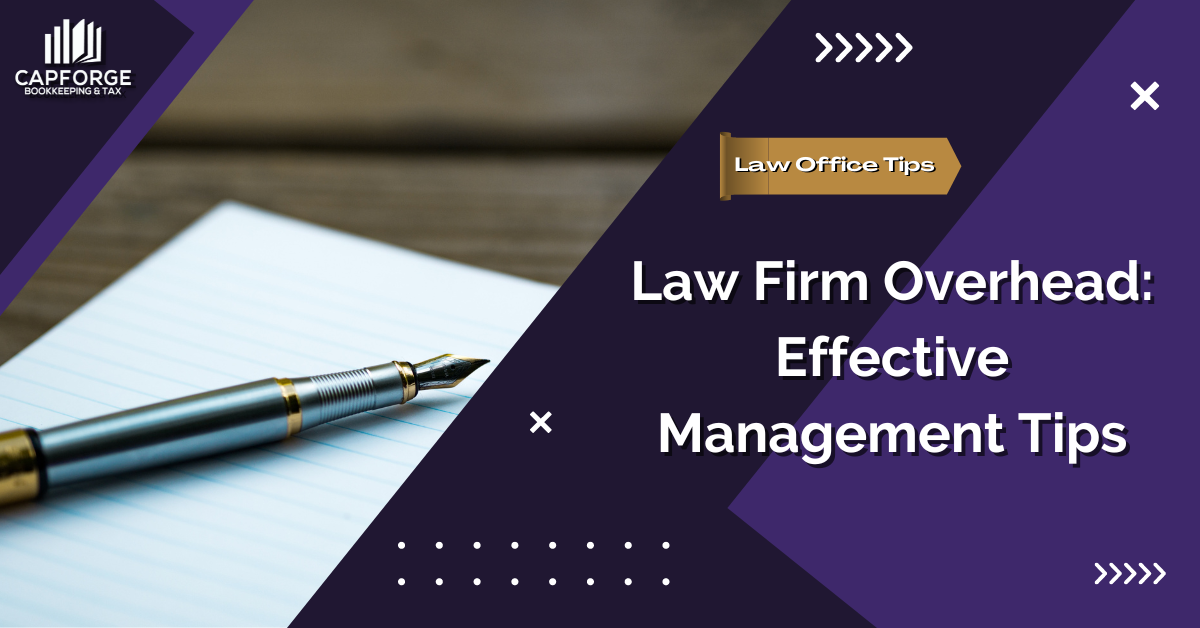Law Firm Overhead: Effective Management Tips
Overhead expenses are a necessary part of running a law firm, but they’re often overlooked in the day-to-day operations of a legal practice. They can include everything from rent and utilities to employee salaries and legal software subscriptions. While law firm overhead may seem burdensome, managing them effectively can result in a more efficient, profitable law firm.
Failure to manage overhead can lead to financial instability and potentially jeopardize the firm’s reputation. Read on to learn how to avoid this scenario and ensure the profitability of your business!
What are the costs involved in law firm overhead?
Before we get started, let’s talk about the expenses involved in a firm’s overhead. These expenses are unrelated to an attorney’s salary and are needed to operate the firm daily.
Office space and utilities
A law firm’s physical location often serves as the first impression for potential clients. Hence, the cost of leasing or owning an office space, along with utilities like electricity, water, and internet, forms a substantial part of the law firm’s overhead. The location, size, and amenities of the office directly influence these costs.
Legal software
In an increasingly digital world, investing in legal technology is crucial. Software for case management, e-discovery, document automation, and legal research are integral parts of modern legal practice. These digital tools often come with subscription fees, making them a recurring overhead cost.
Employee benefits & salaries
For a law firm to run smoothly, it needs a competent team of attorneys, paralegals, and administrative staff. Paying competitive salaries and offering benefits like health insurance and retirement contributions are key to attracting and retaining top talent. As such, employee compensation forms a significant part of the law firm’s overhead.
Legal research expenses
Legal practice requires staying up-to-date with the latest rulings, regulations, and legal theory. This process involves subscriptions to law journals, databases, and other research resources. These costs, although often overlooked, form an essential part of the law firm’s overhead.
Marketing and client acquisition costs
Attracting new clients is a significant part of ensuring the law firm’s growth. This involves costs associated with advertising, SEO, website maintenance, public relations, and networking events.
How can you manage law firm overhead?
Managing overhead costs may seem daunting, but in reality, there are steps you can take to minimize indirect expenses to maximize profitability. Here are a couple of tips to keep in mind:
1. Analyzing current overhead costs
Before making any changes, it is crucial to analyze the current overhead costs. Identify the major expenses and evaluate their impact on the firm’s financial health. This analysis will provide insights into areas where cost reductions or optimizations are possible.
2. Reducing rent and office expenses
One significant overhead expense for law firms is rent and office-related costs. Consider renegotiating lease agreements to obtain more favorable terms. Alternatively, evaluate the feasibility of downsizing office space or exploring shared office arrangements. Additionally, explore opportunities to reduce utility costs by adopting energy-efficient practices.
3. Streamlining administrative functions
Law firms often have complex administrative functions that can be streamlined to improve efficiency and reduce costs. Evaluate the workflow of administrative tasks and identify areas where automation or outsourcing can be implemented. For example, using practice management software can streamline document management and timekeeping processes.
4. Leveraging technology for efficiency
Embracing technology can significantly contribute to reducing law firm overhead. Invest in practice management software, document automation tools, and cloud-based storage solutions. These technologies enhance productivity, facilitate collaboration, and reduce the need for extensive physical infrastructure.
5. Implementing cost-effective marketing strategies
Marketing is essential for attracting new clients, but it can also consume a significant portion of the firm’s budget. Consider cost-effective marketing strategies, such as leveraging digital platforms, content marketing, and search engine optimization (SEO). Focus on targeting the right audience and optimizing marketing efforts to maximize return on investment (ROI).
6. Monitoring and controlling expenditures
Regularly monitor and control expenditures to prevent unnecessary overspending. Implement budgeting processes and tracking systems to gain visibility into the firm’s financial performance. Review expenses regularly and identify areas where cost-cutting measures can be implemented without compromising the quality of services provided.
7. Investing in employee training and development
Investing in the training and development of employees can yield long-term benefits for a law firm. Well-trained staff can handle tasks more efficiently, leading to improved productivity and client satisfaction. Provide opportunities for professional development, such as continuing education programs and workshops.
8. Managing cash flow effectively
Maintaining a healthy cash flow is crucial for managing law firm overhead. Develop efficient billing and collections processes to ensure timely payment from clients. Consider implementing retainer agreements to secure upfront payments for services rendered.
9. Outsourcing non-essential tasks
Outsourcing non-essential tasks can be a cost-effective solution for law firms. Identify tasks that can be outsourced, such as bookkeeping, IT support, or marketing activities. Outsourcing allows the firm to access specialized expertise without the need for additional full-time staff.
10. Prioritizing client retention and referrals
Retaining existing clients and encouraging referrals is a cost-effective way to grow a law firm. Focus on providing exceptional client service, maintaining regular communication, and exceeding client expectations. Implement referral programs to incentivize clients to refer their acquaintances to the firm.
Conclusion
Effectively managing law firm overhead is essential for the financial health and sustainability of the firm. By implementing strategies such as analyzing current costs, reducing rent and office expenses, leveraging technology, and prioritizing client retention, law firms can optimize their overhead and improve profitability.
Does your law firm need help with sorting its financial records? If so, our team is here to help. Feel free to fill out the form below, and we’ll get in touch with you shortly.








